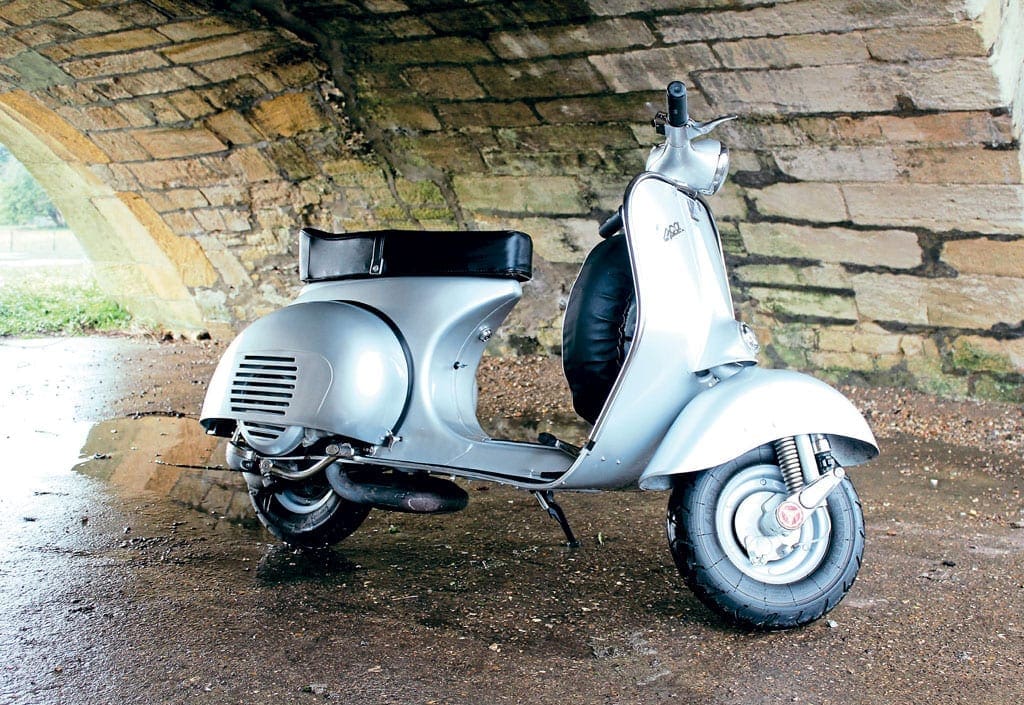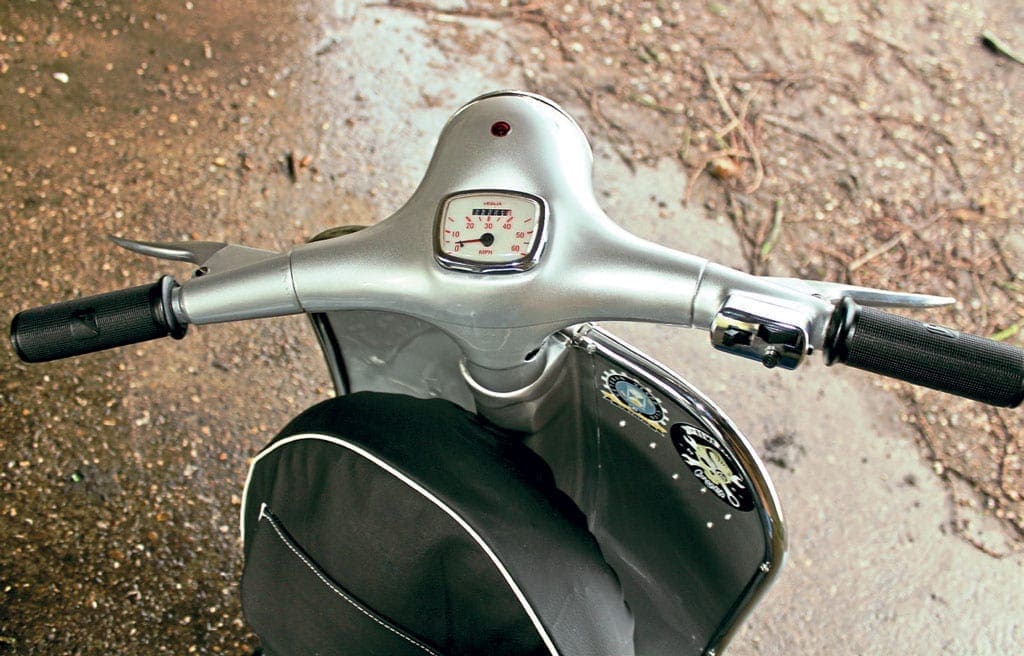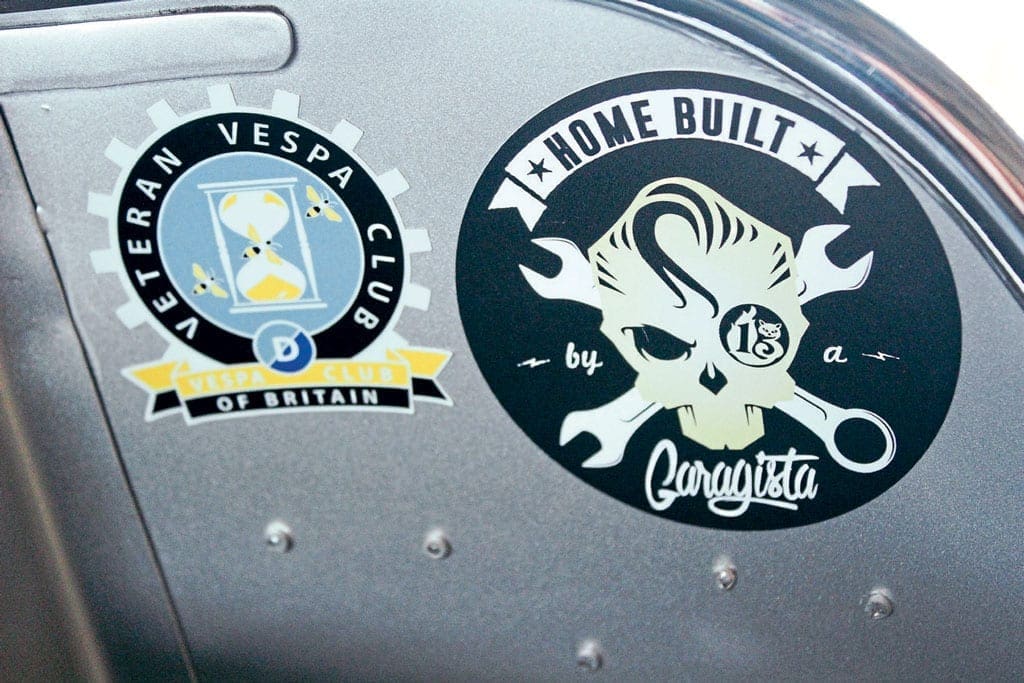
Words & Photographs: Sarge | Build Images: Chris Eldridge
Four years ago Chris Eldridge began in earnest realising twin scooter aspirations he’d possessed for as long as he can remember.
Getting an interest in both scooters and the scene in the early 80s, Chris’s first rally experience was Colwyn Bay in either 82 or 83. His interest blossomed into what would become a lifelong obsession after his first national.
“I’ve always fancied owning and riding an old ‘fat-arse’ Vespa. I didn’t want a VBB or a Sprint, both being too skinny looking for me. I’ve also had a vague intention to totally refurbish a scooter, from top to bottom, myself. I’d been keeping my eyes and ears open for a suitable old Vespa for a while.
“Fellow club member, Nick Southern kept on grabbing any that came up for sale. I didn’t really know anything about 152L2 Douglas Vespas prior to spotting one for sale local(ish), in 2015. When I got there to see it, let’s just say the few accompanying pictures on a well-known social media site where it was offered for sale were rather flattering.
“In reality, a quick look round revealed that there was going to be a lot of work to resurrect this 59 vintage scooter. Engine wouldn’t turn over, never mind run, the body and framework were not in great condition, and one of the side panels was missing.
“Basically, it was a piece of rubbish, although the very speculative asking price was £1600. I offered £800, which was turned down, and negotiations eventually resulted in my final offer of £1000 being accepted.”

Twist yourself further from the middle of the floor
After getting his newly acquired, non-running old Vespa home and into his man cave, aka shed, it would spend most of the following 12 months or so there. Chris realised that it would need to undergo all manner of intensive restorative surgery, and considerably more than he initially anticipated.
“I honestly didn’t realise exactly how bad the body, frame, floor electrics or engine had deteriorated. When I eventually got it clean, I could see how much filler was practically holding it together.
“Legshields were totally shot; so rotten they were way beyond repair. Large sections of the body and frame were rotten and rusted through, and a raised section on the top of the floorboards had rotted through in places, as had the underside of the floor.
“After discovering the real condition that the Vespa I had bought was in, the stark reality of what was going to be required was a realisation of epic proportions.
“Thankfully, my onset of panic was stopped dead in its tracks by my ‘old man’ Steve Bumpass, a skilled welder and fabricator, who barely batted an eyelid after assessing exactly what was going to be required. With a wry grin calmly stated: ‘Yeah, we can do that.’
“As work progressed, I took a few pics every so often to record the refurbishment process. One of the hardest parts of the entire refurb, without question, was getting the re-made legshield skins to line up true. It proved to be quite a tricky process, but we got it right in the end.
“Once all the body and framework had been refurbished, it all went to an old school friend, Sean Lee, who has a paint spraying business. He did a great job, and helped me decide on the colour.”

You’re getting vibrations down to your feet
Chris’s 152l2 Vespa came with the original 1959 engine fitted, but not only was it a non-runner, it was also seized. Undeterred, and spurred on somewhat by the rotten frame turning out not to be ready for weighing in at a scrap yard, Chris set about bringing the vintage engine back to life. He managed to achieve this eventually, with mixed results.
“I spent quite a bit of time during the evenings and weekends slowly working on the engine. I managed to free it off, got it to turn over, checked over all the relevant parts, rebuilt it, and finally it was ready to try it out. It fired up and ran. I rode it up and down the road more than a few times, discovering that at best, at very, very best, it could reach 37 or 38mph.
“Also, once I got it running something else was revealed. A six-inch-long crack in the engine casing was spitting engine oil out when the engine was running. Plan B was needed, and quick, even though at that point I didn’t have a plan B!
“What I did have was an Indian LML 125 engine not doing much at the time. I thought to myself, it’s a fairly reliable engine, and found that I could obtain an eight-inch wheel converter via SIP, so the 152L2 retained its eight-inch wheels front and back.
“This also integral to the Vespa looking more or less standard, though with the hub converter the LML gear ratios have obviously changed from how they were with a ten-inch wheel. It gives me a more respectable top speed of 45mph, and maybe on a very good day, downhill with a strong tailwind assisting, it might touch 50mph.
“Wide frame early Vespas weren’t made for fast speeds. My 152l2 tootles along nicely, although handling is, I have to say, very different to any other scooter I currently or have previously owned. It’s both interesting, mainly due to the eight-inch wheels I think, and enjoyable to ride.”

Now you’re doing the resurrection shuffle
Needless to say, a scooter built some 60 years ago now, even in showroom condition, probably isn’t well equipped for 21st century roads. During the rebuild, refurbish and restoration process, were there any forced additional changes, or for that matter upgrades needed or made?
“The original wiring loom, was un-rescuable, so an entire new loom, incorporating a send and return for a brake light switch – the 152L2 not having a brake light – was re-made for me by club mate Ricky Wiltshire.
“The loom was supposed to route through a few tubular sections inside the frame, except they were blocked in a number of places, so fitting the new loom was a bit of a ball-ache. I managed to get a twin bulb filament rear light unit from Disco Dez, which, along with adding a brake light switch under the brake pedal, gave me a brake light.
“The single seat it came with, after being restored to how it should be, was what I intended to have on my 152L2. I’ve fitted an inside spare wheel carrier, and spare wheel for obvious, practical reasons, the issue being that the riding position on the single seat made it awkward for my knees.
“I would occasionally clip my knees with the handlebars and also my knees would hit the spare wheel. I prefer how my 152L2 looks with the single seat, but the ttrouble is it’s not adjustable, so I opted for a dual bench seat. It doesn’t look as good as the single seat, but as I can sit a bit further back, it’s more comfortable to ride.
“The front damper has been upgraded from standard to a BGM spring and damper to combat front end dive. It does still dive a bit, though! Rear shock is a PX version. I’ve got the original Douglas leg shield badge, which came with the scooter fitted at the moment, and it is very weathered in appearance.
“I had a look at a NOS Douglas leg shield badge on an internet auction site, but I bowed out when it reached a bid of £200. I’d like a NOS legshield badge, at a sensible price. Other possible additions may include one of those Pinasco highbrake drum assemblies, with perhaps a few bits and bobs to give the engine a tweak or two and to add a few miles on the clock.
“I thoroughly enjoyed the entire process of refurbishing my 152L2. When I first bought the 152L2 I got in touch with Bill Drake, who is a font of knowledge as well as something of a Vespa legend. My 152L2 was registered on 7 April, 1959, in Exeter, and I picked up a few other interesting snippets on the very early history of my 152L2.”



